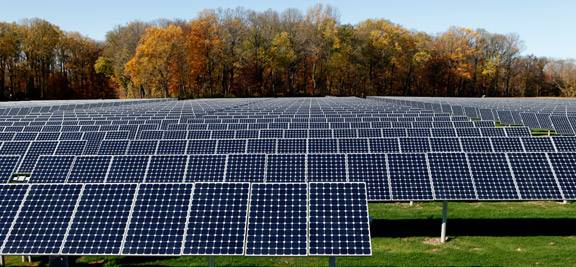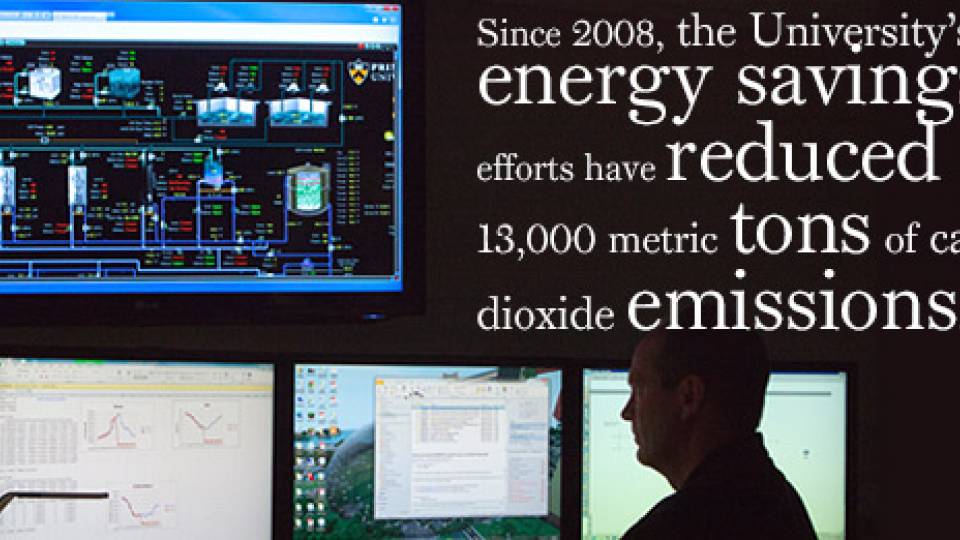Distinctive funding approach may serve as national model
Princeton University will become a leader in American higher education in solar energy when it installs a 5.3-megawatt solar collector field on 27 acres it owns in West Windsor Township. The system, comprising 16,500 photovoltaic panels, is expected to be one of the largest single installations at a U.S. college or university.
Construction could begin as early as this summer and be completed by summer 2012, depending on approvals from local and state authorities. The collector field should generate 8 million kilowatt-hours per year -- enough to power the equivalent of 700 homes or, at Princeton, enough to meet 5.5 percent of the total annual campus electrical needs.
This renewable energy source will be funded and owned by Superior, Colo.-based Key Equipment Finance, which will lease it to Princeton. The project eventually will reduce the University's carbon footprint by decreasing its dependence on fossil fuels and should trim approximately 8 percent per year from its electric costs.
"We are excited at the prospect of realizing the environmental and economic benefits of solar, while also taking a leadership role in advancing renewable energy in a way that could work for many other educational institutions," said Michael McKay, Princeton's vice president for facilities. "In addition to providing a portion of the electricity needs of the main campus, we hope our approach will serve as a national model. We also envision that this system will be used as a teaching tool for Princeton students in various disciplines."
The University is using a distinctive business model that will pay for the system's lease through incentives and by initially selling solar renewable energy credits associated with the system.

About 80 percent of the new solar power system being installed on Princeton University property will be composed of SunPower T0 Trackers, which use a global positioning system to track the sun each day to maximize energy capture. (Photo by Tom Grimes Photography for SunPower)
The project site is located on land adjacent to Princeton's main campus between the New Jersey Transit "Dinky" spur line, the Delaware & Raritan Canal, Washington Road (Mercer County Road 571) and Route 1. A row of trees along Washington Road will block most of the site from view. New landscaping also will be installed to screen the site from the road, the lake and the canal towpath.
The solar power system will be mounted on 4- to 5-foot poles facing south. About 80 percent of the system will be composed of SunPower T0 Trackers, which use a global positioning system to track the sun each day to maximize energy capture. The remainder of the system will use solar technology that fixes the panels at a tilt of 25 degrees. This combination was selected to maximize the amount of power generated and to best fit the irregular layout of Princeton's land, said Tom Leyden, managing director at SunPower Corp., the global solar technology company with East Coast offices in Trenton, N.J., that will design and build the system.
"Princeton's leadership in energy efficiency and clean energy is truly world class," Leyden said. "SunPower is proud to partner with them to deliver this state-of-the-art solar project utilizing the most efficient and reliable photovoltaic technology commercially available."
Power will be delivered to the University's main campus via a cable installed under the canal and Lake Carnegie. The University intends to provide a continuous real-time data stream from the field so that faculty members, students and researchers can use information about the system and its performance in their work. A moderate-height mix of native meadow grasses that do not need to be mowed will be planted under the system in order to enhance the habitat of the site.
Leading the way
The project became economically feasible for the University due to a combination of a federal grant and favorable depreciation treatment available through the American Recovery and Reinvestment Act (ARRA) as well as revenue that will be realized through New Jersey's Solar Renewable Energy Certificate (SREC) program.
As the system owner, Key Equipment Finance will receive the full benefits of the ARRA incentives. The University will "host" the system and enjoy a lower lease rate that reflects these substantial federal incentives.
"Both Princeton University and SunPower have outstanding reputations as organizations that are leading the way in their respective disciplines, and it is our pleasure to partner with such esteemed and forward-thinking institutions," said David ten Kroode, vice president of Key Equipment Finance's energy finance business.
During the eight-year lease, Princeton will sell the SRECs produced by the project to a utility that then will be allowed to claim all environmental benefits. Through the SREC program, managers of solar energy installations can sell "certificates" for the renewable energy they generate. For each 1,000 kilowatt-hours of solar electricity generated, the state of New Jersey issues an SREC, which Princeton then will be able to sell at a price determined by the market. Many states, including New Jersey, require utilities to provide a percentage of their electricity sales from solar generation. Rather than building their own solar plants to meet these targets, suppliers can buy SRECs to achieve compliance with the state's renewable portfolio requirements.
The University will sell the SRECs associated with the system to help pay the lease. However, Princeton will not claim any environmental benefits, such as carbon emissions reduction, until the University stops selling the SRECs and begins "retiring" them, which is expected to occur in 2020.
As part of its Sustainability Plan adopted in 2008, the University is working to reduce its annual carbon dioxide emissions to 1990 levels (95,000 metric tons) by 2020. Retiring the SRECs in 2020 would mean that the University would, from that point on, prevent the emission of approximately 3,090 metric tons of carbon dioxide per year -- 6 percent of the reduction goal. The solar power system is designed to last 30 years or more.
"What's more important than the size of the project is the leadership role we're taking," said Ted Borer, Princeton's energy plant manager. "We're using a business model for the system that others will want to adopt by first paying for the system through incentives and SRECs and then stopping selling the SRECs and retiring them so we make a real and significant emissions reduction ourselves. At the same time, we anticipate saving much more money than other organizations by leasing the solar PV (photovoltaic) equipment rather than buying power through a 'Power Purchase Agreement.' This will allow Princeton to benefit from the full SREC value and the full energy savings for the life of the system.
"I believe that when people hear about what we've achieved and realize how much more financial and environmental benefit we've delivered than almost any other solar host before," Borer added, "they'll want to pursue this funding model."
Forging ahead
Two other solar systems recently have been installed on the University's campus: an array of some 5,000 panels installed in 2009 on the roof of the building that houses the Research Collections and Preservation Consortium (ReCAP) on the Forrestal Campus about three miles north of Princeton's main campus; and an array of 216 panels on the newly completed Frick Chemistry Laboratory on the main campus. The three institutions that store books at ReCAP -- Princeton and Columbia universities and the New York Public Library -- are serving as solar hosts, while Pennsylvania Power & Light owns the system and the SRECs.
Because of its relatively small size, the chemistry installation is more notable for its design -- panels that not only convert solar energy into electricity but also provide shade over the glass roof to reduce glare and the air conditioning requirements. ReCAP is not connected to the University's central power plant, while Frick Chemistry Laboratory is and so will be the new solar project in West Windsor.
Princeton powers its main campus using a central cogeneration plant that provides steam heat to most buildings on campus and, in the summer, chilled water for air conditioning. It also generates 15 megawatts of electricity -- approximately half of the power used on campus. The University purchases the remainder of its electricity from Public Service Electric and Gas Co. Princeton's new solar installation will be connected to the central power plant through the Charlton Street substation on campus, and will reduce purchases of electricity from the grid.
"When it opened in 1996, the cogeneration plant gave us a tremendous boost in terms of energy conservation and greenhouse gas reductions at the University," McKay said. "It's our responsibility to keep forging ahead, and we see this plan for solar energy as one of several next steps."
The solar photovoltaic system will be a significant contributor among a number of other strategies the University is employing to reach its 2020 greenhouse gas reduction goals without the purchase of market offsets. Princeton also is improving the efficiency of the cogeneration plant and the buildings it serves, and has reduced its emissions over the last two years by 2.5 percent.


